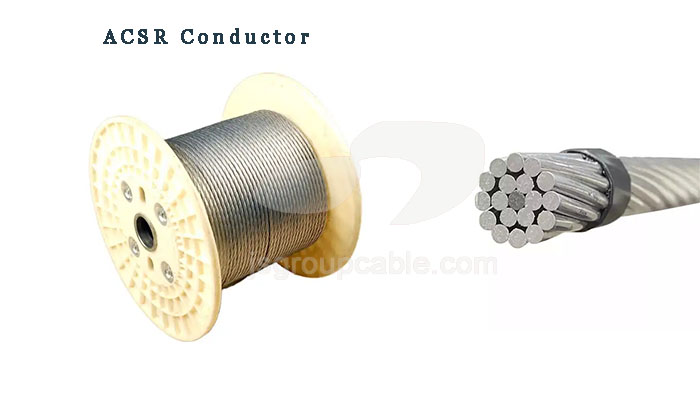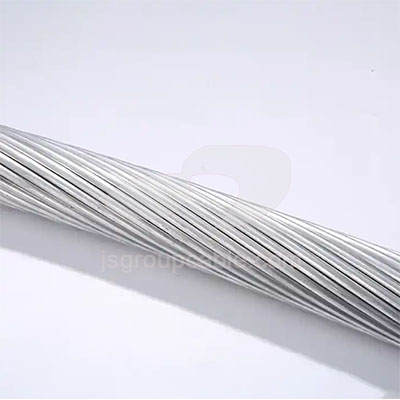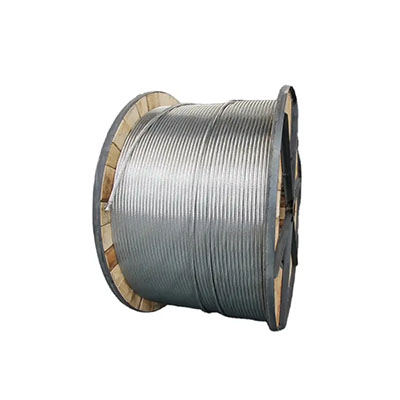- Offices Time:24 Hours Online
- Email:[email protected]
- WhatsApp:+8618339938759

Posted on March 3, 2023
How much is ACSR conductor?
ACSR stands for “Aluminum Conductor Steel Reinforced“. It is a type of electrical conductor used for overhead power transmission and distribution lines. It consists of a central steel core surrounded by one or more layers of aluminum wire.The steel core provides the conductor with its strength, while the aluminum wires provide the conductivity. The combination of the steel and aluminum allows for a conductor that is strong, lightweight, and has good electrical conductivity.
ACSR conductor are commonly used for high-voltage transmission lines that span long distances. They are also used in areas with high wind and ice loads, as the steel core provides additional strength to withstand these conditions. ACSR conductor come in a variety of sizes and configurations to meet the specific requirements of different power transmission and distribution applications.

What are the types of ACSR conductor?
There are several types of ACSR (Aluminum Conductor Steel Reinforced) conductor available, and they are generally named based on the specific materials used and the design of the conductor. Here are some common types:
1.Standard ACSR: This is the most common type. It typically consists of a central steel core surrounded by one or more layers of aluminum wire.
2.High-strength ACSR: This type is designed with a higher steel core strength to withstand greater loads and stresses.
3.Extra-high-strength ACSR: This type has an even higher steel core strength than high-strength ACSR and is suitable for long spans or heavy loads.
4.Composite ACSR: This type of ACSR conductor includes composite materials in addition to the traditional steel and aluminum components, providing additional strength and durability.
5.Gap conductors: This type has a special design that allows it to reduce the electrical potential gradient between conductors, reducing the likelihood of corona discharge.
6.Anti-corrosion ACSR: This type is coated or designed with anti-corrosion materials to improve its longevity in harsh environments.
The selection of the appropriate conductor type depends on the application and specific requirements of the transmission line. It is essential to consult with experienced professionals to determine the most suitable type of conductor for your specific needs.
Aluminum Conductor Steel Reinforced is in Accordance with ASTM B232-81
| Code Name | Aluminum Sectional Area | Stranding No. and Dia. | ApproxOverall Dia(mm) | Max.D.C Resistance aApprox. Weight(kg/km)t 20℃(Ω/km) | Calculated Breaking Load(KN) | Max.D.C Resistance at 20℃(Ω/km) | ||
| Cir.mils or AWG | (mm²) | Al. | St. | |||||
| Turkey | 6 | 13.3 | 6/1.68 | 1/1.68 | 5.04 | 53.75 | 5303 | 2.157 |
| Swan | 4 | 21.18 | 6/2.12 | 1/2.12 | 6.36 | 85.57 | 8302 | 1.355 |
| Swanate | 4 | 21.12 | 7/1.96 | 1/2.61 | 6.53 | 99.56 | 10642 | 1.352 |
| Sparrow | 2 | 33.59 | 6/2.67 | 1/2.67 | 8.01 | 135.7 | 12653 | 0.854 |
| Sparate | 2 | 33.54 | 7/2.47 | 1/3.30 | 8.24 | 158.6 | 16171 | 0.852 |
| Robbin | 1 | 42.41 | 6/3.00 | 1/3.00 | 9 | 171.4 | 15852 | 0.676 |
| Raven | 1/0 | 53.52 | 6/3.37 | 1/3.37 | 10.1 | 216.2 | 19455 | 0.536 |
| Quail | 2/0 | 67.32 | 6/3.78 | 1/3.78 | 11.3 | 272 | 23529 | 0.426 |
| Pigeon | 3/0 | 85.14 | 6/4.25 | 1/4.25 | 12.8 | 344 | 29417 | 0.337 |
| Penguin | 4/0 | 107.2 | 6/4.77 | 1/4.77 | 14.3 | 433.4 | 37055 | 0.268 |
| Wax wing | 266800 | 135 | 18/3.09 | 1/3.09 | 15.5 | 430.5 | 30519 | 0.213 |
| Partridge | 266800 | 134.9 | 26/2.57 | 7/2.00 | 16.3 | 545.4 | 26403 | 0.214 |
| Ostrich | 300000 | 152.2 | 26/2.73 | 7/2.12 | 17.3 | 614.6 | 56410 | 0.19 |
| Merlin | 336400 | 170.2 | 18/3.47 | 1/3.47 | 17.4 | 542.9 | 38487 | 0.169 |
| Linnet | 336400 | 170.6 | 26/2.89 | 7/2.25 | 18.3 | 689.9 | 62918 | 0.169 |
| Oriole | 336400 | 170.5 | 30/2.69 | 7/2.69 | 18.8 | 784.5 | 77267 | 0.17 |
| Brant | 397500 | 201.6 | 24/3.27 | 7/2.18 | 19.6 | 762.5 | 65099 | 0.143 |
| Ibis | 397500 | 201.3 | 26/3.14 | 7/2.44 | 19.9 | 813.5 | 72426 | 0.143 |
| Lark | 397500 | 200.9 | 30/2.92 | 7/2.92 | 20.4 | 924.4 | 90485 | 0.144 |
| Pelican | 477000 | 242.3 | 18/4.14 | 1/4.14 | 20.7 | 772.6 | 52302 | 0.119 |
| Flicker | 477000 | 241.7 | 24/3.58 | 7/2.39 | 21.5 | 914.9 | 73243 | 0.12 |
| Hawk | 477000 | 241.6 | 26/3.44 | 7/2.67 | 21.8 | 975.5 | 86011 | 0.12 |
| Hen | 477000 | 241.3 | 30/3.20 | 7/3.20 | 22.4 | 1,110.00 | 105611 | 0.12 |
| Osprey | 556500 | 282.4 | 18/4.47 | 1/4.47 | 22.4 | 900.7 | 60972 | 0.12 |
| Parakeet | 556500 | 282.2 | 24/3.87 | 7/2.58 | 23.2 | 1068.00 | 84424 | 0.103 |
| Dove | 556500 | 282.6 | 26/3.72 | 7/2.89 | 23.6 | 1142.00 | 100838 | 0.103 |
| Eagle | 556500 | 282.1 | 30/3.46 | 7/3.46 | 24.2 | 1298.00 | 123470 | 0.103 |
| Peacock | 605000 | 306.2 | 24/4.03 | 7/2.69 | 24.2 | 1159.00 | 95861 | 0.0948 |
| Squab | 605000 | 307.2 | 26/3.87 | 7/3.01 | 24.5 | 1236.00 | 108317 | 0.0944 |
| Duck | 605000 | 307.2 | 30/3.61 | 7/3.61 | 25.3 | 1414.00 | 128736 | 0.0945 |
| Teal | 605000 | 307.2 | 30/3.61 | 19/2.16 | 25.2 | 1398.00 | 133082 | 0.0945 |
| Kingbirad | 636000 | 323.1 | 18/4.78 | 1/4.78 | 23.9 | 1031.00 | 69722 | 0.089 |
| Rook | 636000 | 323 | 24/4.14 | 7/2.76 | 24.8 | 1222.00 | 101038 | 0.0894 |
| Egret | 636000 | 322.5 | 30/3.70 | 19/2.22 | 25.9 | 1472.00 | 14029 | 0.0897 |
| Flamingo | 666600 | 337.2 | 24/4.23 | 7/2.82 | 25.4 | 1276.00 | 105478 | 0.0856 |
| Gannet | 666600 | 338.3 | 26/4.07 | 7/3.16 | 25.8 | 1366.00 | 117258 | 0.0854 |
How to choose a suitable ACSR conductor?
Choosing the right conductor depends on several factors such as the purpose of the transmission line, the terrain, the length of the transmission line, and the expected load. Here are some key factors to consider when choosing an ACSR conductor:
1.Electrical specifications
The rated voltage, current capacity and resistance of the conductor need to be considered. These parameters must meet the requirements of the transmission line.
2.Terrain and weather conditions
Consider the terrain and weather conditions where the transmission line will be installed. It with higher strength and corrosion resistance may be required for harsh environments.

3.Length of transmission line
The length of the transmission line affects the sag of the conductor. Therefore, the ACSR conductor’s size and strength should be selected according to the required sag, which is dependent on the transmission line’s length.
4.Expected load
The conductor’s size should be selected according to the expected load. This will ensure that the conductor can carry the required current safely without overheating or breaking.
5.Regulatory requirements
Consider any regulatory requirements for the specific application, such as those related to fire resistance, environmental impact, or safety standards.
Overall, it is important to consult with experienced professionals such as electrical engineers and transmission line experts to ensure the correct conductor is chosen for your specific application.
How much is ACSR conductor?
The price of ACSR (Aluminum Conductor Steel Reinforced) conductor varies depending on various factors such as the current market demand and supply, location, manufacturer, and quantity ordered.

To give you a general idea of the price range, the price of ACSR can range from a few hundred to several thousand dollars per kilometer, depending on the factors mentioned above. For example, if the demand for ACSR conductor is high, the price may increase due to limited supply, while if the supply is high, the price may decrease due to competition among manufacturers.
In addition, the location also plays a crucial role in determining the price of ACSR conductor. The cost of transportation and logistics can add to the total price, especially if the location is far from the manufacturing site.
The quantity ordered can also affect the price. Bulk orders typically come with a discounted price, while smaller orders may have a higher per-unit price due to the additional cost of handling and shipping.
So, the price of ACSR conductor varies depending on several factors such as market demand and supply, location, manufacturer, and quantity ordered. To get an accurate price quote, it’s best to contact local suppliers or manufacturers directly.
- Previous:Applications of Quadruplex wire
- Next:What is 1/0 Welding Cable?
Post categories
Most Popular Posts
-
The 136th Canton Fair welcomes you to participate!
October 12, 2024 -
High temperature cable introduction
July 26, 2024 -
Kenya Power and Energy Exhibition 2024
June 11, 2024 -
Introduction of rubber sheathed cable
June 5, 2024





